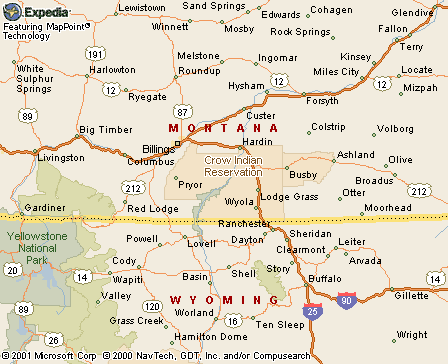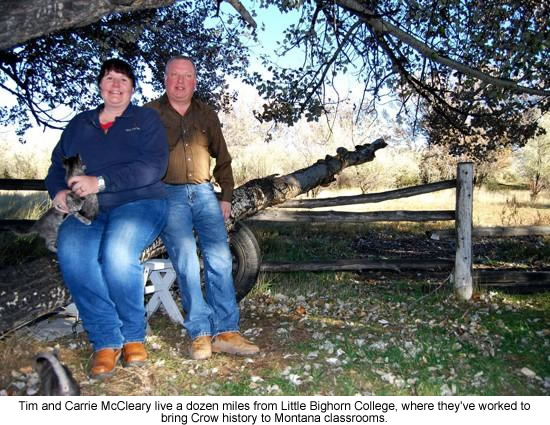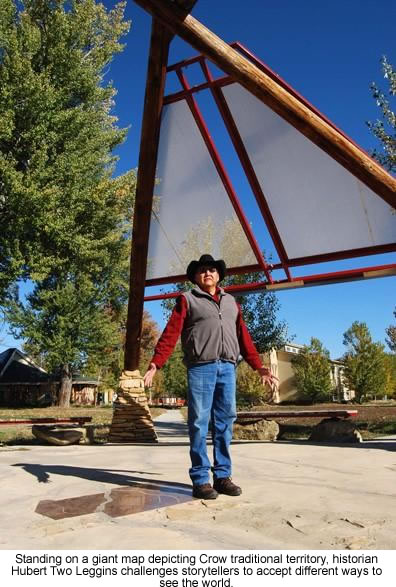 |
Canku Ota
|
 |
|
(Many Paths)
|
||
|
An Online Newsletter
Celebrating Native America
|
||
|
February 1, 2009 - Volume
7 Number 2
|
||
|
|
||
|
Long-ago Lessons
Echo Among Crow
|
||
|
by Rob Chaney - The
Missoulian
|
||
|
Montana is the only state in the nation with a constitution commanding respect for its American Indian heritage in its public schools. Yet, for decades after that goal was drafted, little was done to introduce its tribal nations to mainstream culture. That changed two years ago, when education leaders launched the Montana Tribal History Project. Missoulian reporter Rob Chaney received a fellowship from Columbia University's Hechinger Institute on Education and the Media to examine the project coming to the state's public schools. This series investigates how these tribal histories came to be and how they will affect everyone in Montana.
I had traveled 350 miles to meet Hubert Two Leggins in Crow Agency, the self-titled Tipi Capital of the World. His office was crammed with stacks of DVD copies and boxes of textbooks, so we went outside to enjoy a bright fall day on the Little Big Horn College campus. Two Leggins coordinated the college's tribal history project, and I'd come to hear what he'd learned. "I've found where we came from, what we ate, where we lived," Two Leggins said. "I'm trying to teach the children, although some adults don't know what I know." And he told the story of Big Metal: A group of Crow were camped along the Big Horn, hunting. One boy was taken for a hunting trip by his stepfather, who was treating him very nicely. They were going to hunt bighorn sheep. But the stepfather really wanted to kill the boy, so, when they reached the canyon rim, he told the boy to look over at some sheep. Then the stepfather pushed the boy over the cliff, took his horse and rode back to camp. The stepfather said he and the boy got separated and pretended to wonder where the boy was. The boy's mother began to panic, and the camp leaders sent their best scouts to find him. But the stepfather gave them false directions. The boy actually got hung up on a cedar branch growing out of the cliff wall. At "Non-Indians will say 'that's myth,' " Two Leggins said. "When animals start talking, they say it's myth or folklore. Their understanding stops right there." Lessons
learned The head ram spoke to him, saying four rams would carry him to the top of the cliff. The head ram told the boy not to open his eyes or look down while the other rams were carrying him. Each of the four rams took turns carrying him to the top of the cliff. The last one was called Big Metal, and he was the strongest. When they reached the top, they all gave the boy gifts of knowledge and wisdom and told him that he would also learn things from the badger. The badger represents stubbornness and strength. When he holds to the ground, even the bear can't chase him away. The Crow got tepee stakes from the badger. Before that, they used rocks to hold down the tepees. The boy went home and was welcomed. As for the stepfather, the rams told the boy to walk past the man and not do anything to him and to not let anyone in the camp touch him. Instead the boy was to throw a piece of sinew into his mother's fire. The next day, the stepfather was found mangled and unrecognizable, like the sinew in the fire. The boy also took the name Big Metal. He lived to a great age, and, when he died, he was placed on a scaffold near the Bighorn River. "We know where it is," Two Leggins said of the burial spot. "This story is a true story to us. It didn't come from a clan father or mother, but from an animal who spoke the language. To us, it's like the Cinderella story."
Wording is serious because oral tradition often depends on special currents of speech to help the teller remember the tale properly. If Two Leggins told me the tale again, I bet he'd repeat it beat for beat, like I'd recite a Shakespeare soliloquy. A reporter is a professional storyteller. But a reporter's methods are a world away from Big Metal. Two Leggins' colleague, Little Big Horn College anthropology professor Tim McCleary, explained how there are even variations in kinds of oral history speech. Some stories, like Big Metal, are tales of the distant or uncertain past. Such adventures are told in a narrative style: First he went to the canyon, and then this happened. But Crow oral tradition also has historical stories, and these must be told in the first person: I went to the canyon, and I saw this happen. The teller represents the original witness to the event. "These are told in the first person because changing them to third person alters the story and may affect its truth," McCleary said. "Changing the grammar changes the perspective, and that may change the facts." McCleary spent several years as the staff historian at Little Bighorn Battlefield, site of Lt. Col. George Armstrong Custer's defeat. The story, or history, of that place is as braided as the reach of the Little Bighorn River that runs past the college, in the bottom land where Sitting Bull's huge gathering was camped on June 25, 1876. "In white culture, there are different versions," McLeary said. "There's what's known as the 'Custer Myths' that are treated as fact by the way historians wrote about it." McCleary's ranch house sits a dozen miles west of the Little Bighorn River. The land between tumbles and twists among small hills and coulees, opening suddenly into the Bighorn River bottoms. The two rivers run parallel but oblivious to each other, like written and oral history. From
verbal to written McCleary acknowledged that turning one into the other is problematic. How do we know that, somewhere between a great-great-grandfather and a grandson, an important detail didn't get mangled or exaggerated? When McCleary was doing research on Crow astronomy in 1997, he interviewed many elders about the stories attached to major constellations. There was Iipchaiapaachuoo, the Pipe-pointer Stars, that whites call the Big Dipper, and Ihkawaieische, the Hand Stars (Orion). Most of the stories followed similar narratives, except for two elders who told him versions that differed greatly from the other sources. "In mainstream scientific practice, you throw out the outliers," McCleary said. "I figured those two guys misheard it somewhere along the way." But then McCleary found a collection of 1920s field notes that included constellation narratives. And those notes repeated his outlier stories almost word for word. Do these variations and styles of storytelling really matter? Two Leggins' task for the past two years has been to compile Crow history into books for Montana's public school children to study. But much of his work has focused on the time of Big Metal and before, going back 5,000 years to the Pre-Siouan language origins of Crow culture. "I've been to that site," he said of Big Metal's burial scaffold. "There's about 2,000 tepee rings there. You can tell a Crow tepee because they use four base poles and an oblong shape, not round like other tribes. We know horses came to the Crow in the 1700s, and we know the story of Big Metal took place just before we got horses. "And now we have proof right at the time of this story, when we got horses, we also went from stones to stakes. There was a group of college students carbon-dating the tepee rings. The campfires there are 300 years old. "We're able to connect that story to where it's true that animals do talk. They call it myth or legend, but they're actually true stories or events - that's how I see things." Lay
of the land It's a plaza surmounted by four poles, symbolizing an oblong Crow tepee. In the center of the concrete floor is a brown stone carved in the shape of the Crow Reservation. It's about the size of a welcome mat in a home's doorway. The rest of the 30-by-40-foot plaza has several other groupings of triangles in the concrete. They represent the Three Forks of the Missouri in the northwest, Wyoming's Wind River Range in the southwest, the confluence of the Yellowstone and Missouri rivers in the northeast and South Dakota's Black Hills in the southeast. That encompasses 38 million acres, including two-thirds of Yellowstone National Park, Mount Rushmore, S.D., the cities of Billings and Bozeman and Cody and Rapid City, S.D. The Crow claim this as ancestral territory. But it isn't just a matter of oral tradition. They got it written down by the U.S. government in the Treaty of 1851. Surely the federal law of the land is as reliable as a talking animal? |
 Crow Indian Reservation map |
www.expedia.com |
|
|
||
|
|
||
| Canku Ota is a free Newsletter celebrating Native America, its traditions and accomplishments . We do not provide subscriber or visitor names to anyone. Some articles presented in Canku Ota may contain copyright material. We have received appropriate permissions for republishing any articles. Material appearing here is distributed without profit or monetary gain to those who have expressed an interest. This is in accordance with Title 17 U.S.C. Section 107. | ||
|
Canku Ota is a copyright ©
2000, 2001, 2002, 2003, 2004, 2005, 2006, 2007, 2008, 2009 of Vicki
Barry and Paul Barry.
|
||
 |
 |
|
|
The "Canku
Ota - A Newsletter Celebrating Native America" web site and
its design is the
|
||
|
Copyright ©
1999, 2000, 2001, 2002, 2003, 2004, 2005,
2006, 2007, 2008 of Paul C.
Barry.
|
||
|
All Rights Reserved.
|
||
 CROW
AGENCY - This is a story about telling stories.
CROW
AGENCY - This is a story about telling stories. Words
count
Words
count